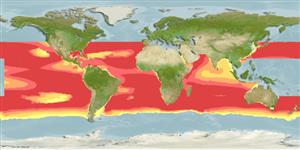Teleostei (teleosts) >
Stomiiformes (Lightfishes and dragonfishes) >
Stomiidae (Barbeled dragonfishes) > Astronesthinae
Etymology: Neonesthes: Greek, neos = new + Greek, esthes = suit, something used to wrap (Ref. 45335).
Environment: milieu / climate zone / depth range / distribution range
Ecology
Marine; bathypelagic; depth range 70 - 1650 m (Ref. 58302). Deep-water; 40°N - 55°S
Eastern Atlantic: southern Portugal to Mauritania, and from Namibia to South Africa. Western Atlantic: USA to Gulf of Mexico including western Caribbean, and from Brazil to Argentina. Indian Ocean: mostly 25°S, also taken in Arabian Sea. Pacific: mostly south of 25°S, also near Hawaii, off western USA.
Size / Weight / Age
Maturity: Lm ? range ? - ? cm
Max length : 17.0 cm SL male/unsexed; (Ref. 4465)
Dorsal spines (total): 0; Dorsal soft rays (total): 8 - 12; Anal spines: 0; Anal soft rays: 22 - 28. Body black in color, often iridescent (Ref. 3982). Teeth in jaws uniserial, very short, spine-like, about equally spaced (Ref. 559). Snout shorter than eye (Ref 559). Anal fin with many rays; its base long, more than twice that of dorsal (Ref. 559). Gill rakers much attenuated, numerous, close together (Ref. 559).
An oceanic and mesopelagic species usually found deeper than 500 m during the day (Ref. 2802). Feeds on midwater fishes and crustaceans (Ref. 2802). Also Ref. 58302.
Life cycle and mating behavior
Maturity | Reproduction | Spawning | Eggs | Fecundity | Larvae
Gibbs, R.H. Jr., 1990. Astronesthidae. p. 300-307. In J.C. Quero, J.C. Hureau, C. Karrer, A. Post and L. Saldanha (eds.) Check-list of the fishes of the eastern tropical Atlantic (CLOFETA). JNICT, Lisbon; SEI, Paris and UNESCO, Paris. Vol. 1. (Ref. 4465)
IUCN Red List Status (Ref. 130435: Version 2024-1)
Threat to humans
Harmless
Human uses
Tools
Special reports
Download XML
Internet sources
Estimates based on models
Preferred temperature (Ref.
123201): 5.3 - 14.7, mean 9.5 °C (based on 779 cells).
Phylogenetic diversity index (Ref.
82804): PD
50 = 0.7500 [Uniqueness, from 0.5 = low to 2.0 = high].
Bayesian length-weight: a=0.00417 (0.00171 - 0.01014), b=3.05 (2.84 - 3.26), in cm total length, based on LWR estimates for this (Sub)family-body shape (Ref.
93245).
Trophic level (Ref.
69278): 4.0 ±0.66 se; based on food items.
Resilience (Ref.
120179): High, minimum population doubling time less than 15 months (Preliminary K or Fecundity.).
Fishing Vulnerability (Ref.
59153): Low vulnerability (11 of 100).
